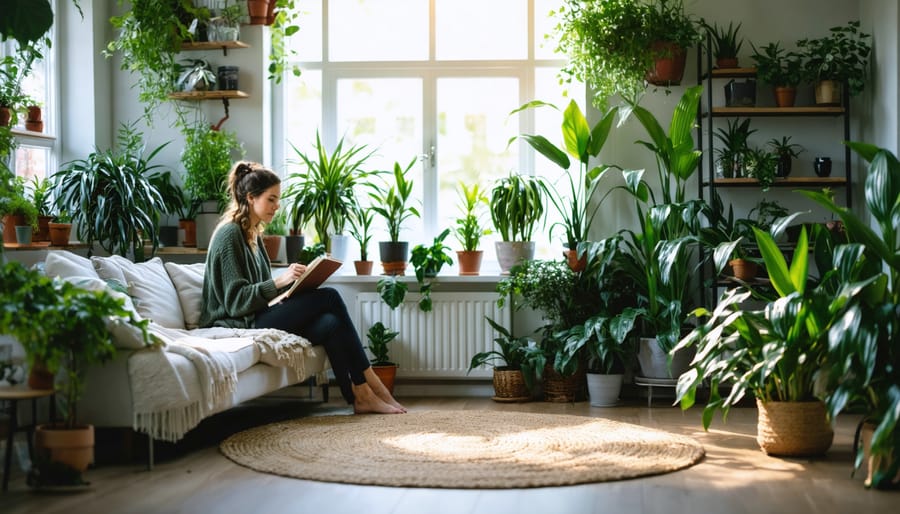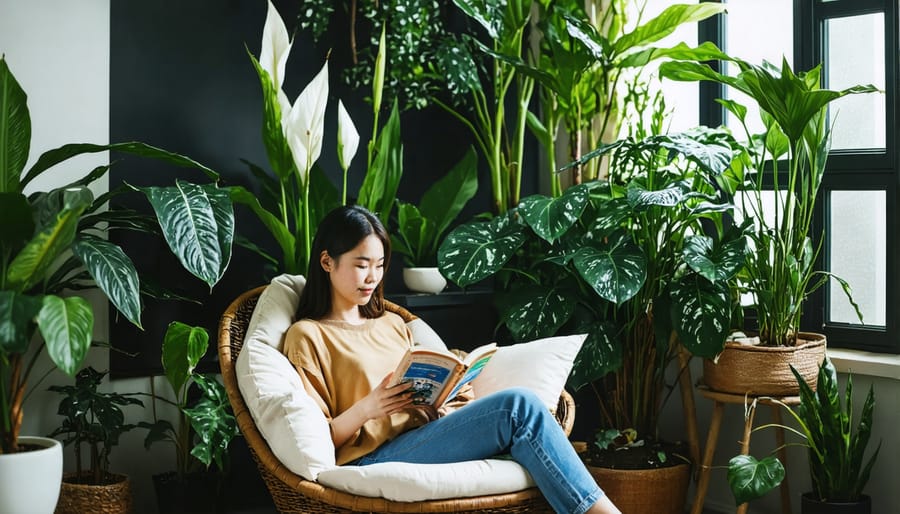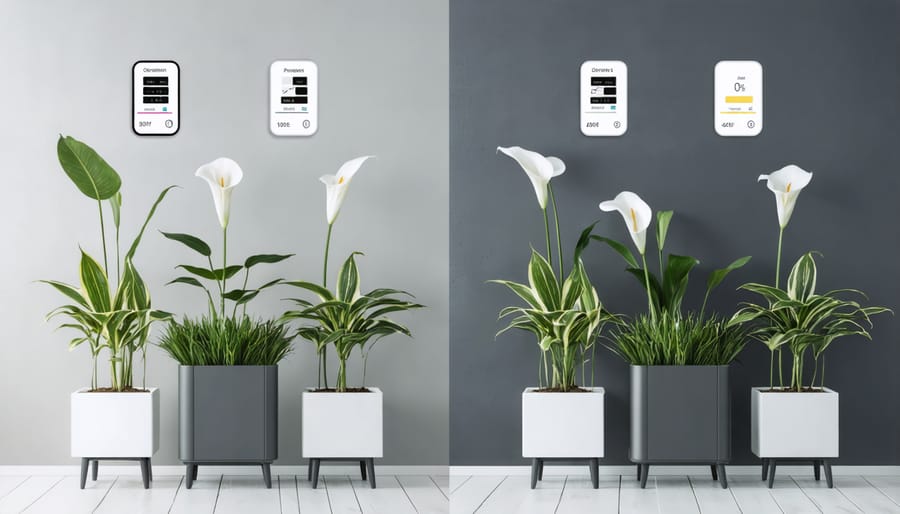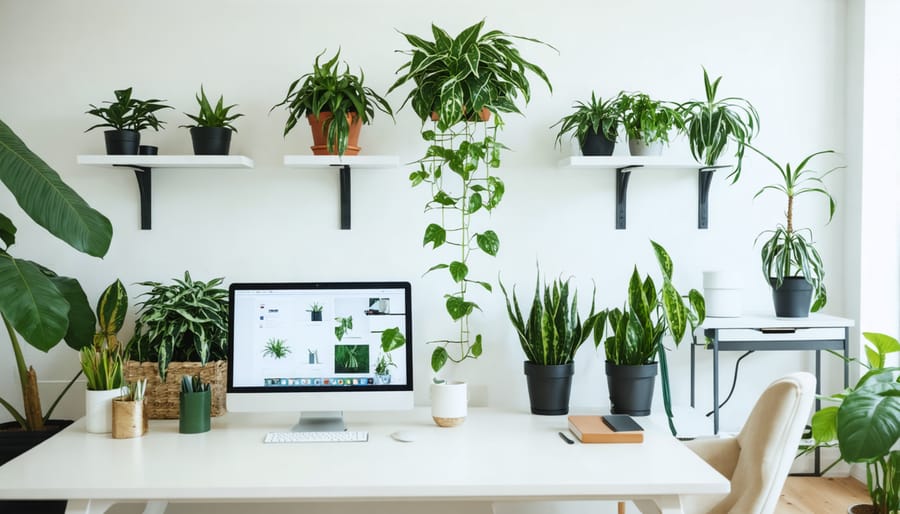
Transform your home into a vibrant wellness sanctuary with strategic indoor plant placement. Recent NASA studies confirm that common houseplants like snake plants and peace lilies can remove up to 87% of indoor air toxins within 24 hours, while boosting humidity levels to optimal ranges between 30-60%. Beyond purifying your air, these green companions naturally reduce stress hormones by up to 15% when incorporated into your daily environment, according to research published in the Journal of Physiological Anthropology.
Living walls and clustered plant arrangements in home offices have been shown to increase productivity by 15% and creativity by 45%, while reducing anxiety and fatigue. The simple act of tending to plants triggers the release of serotonin and dopamine, creating a natural mood boost that rivals traditional stress-management techniques. Whether you’re a busy professional seeking calm or a wellness enthusiast looking to enhance your living space, indoor plants offer an accessible, science-backed way to elevate both your physical health and emotional wellbeing.
How Indoor Plants Boost Your Mental Health
Stress Reduction and Mood Enhancement
Have you ever noticed how your shoulders relax and your breath deepens when you walk into a room filled with lush, green plants? That’s not just your imagination at work. Scientific research has consistently shown that indoor plants can be powerful allies in our battle against daily stress and anxiety.
A famous study by the Journal of Physiological Anthropology found that interacting with indoor plants can actually reduce both psychological and physiological stress. Participants who spent just a few minutes tending to a potted plant showed significantly lower levels of cortisol, often known as the stress hormone, compared to those who completed other tasks.
As someone who keeps a small potted peace lily on my desk, I’ve personally experienced how having a green companion can make hectic workdays feel more manageable. There’s something inherently calming about watching leaves gently sway in the breeze from a nearby window or focusing on watering your plants when feeling overwhelmed.
Beyond stress reduction, indoor plants have been linked to improved mood and increased feelings of wellbeing. The presence of plants in hospital rooms has been shown to speed up recovery times and reduce anxiety levels among patients. At home, they can create a similar healing atmosphere, serving as natural mood boosters, especially during those grey winter months when we spend more time indoors.
The best part? You don’t need a jungle-worthy collection to reap these benefits. Even a single plant in your living space can make a difference in your mental wellbeing.

Productivity and Creativity Boost
As someone who transitioned to working from home, I discovered that my collection of indoor plants became more than just décor – they transformed into productivity-boosting companions. Studies have shown that having plants in your workspace can increase productivity by up to 15%, and I’ve personally experienced this boost in my own home office.
The secret lies in how plants affect our mental state. When you’re stuck on a challenging project or feeling creatively blocked, simply gazing at the lush greenery can help reset your mind. Plants create what designers call “soft fascination,” a gentle way of holding your attention that allows your brain to restore its focus naturally.
For creative professionals, plants do more than just enhance concentration. Their organic shapes and varying textures can spark inspiration and innovative thinking. I’ve noticed that my writing flows more easily when I’m surrounded by my leafy friends, and many artists and designers report similar experiences.
If you’re setting up a work-from-home space, consider placing a peace lily or snake plant on your desk. These low-maintenance options not only purify the air but also add a touch of natural beauty that can help maintain your focus throughout the day. For creative spaces, try incorporating plants with interesting patterns like calatheas or the sculptural beauty of a monstera to stimulate your imagination.
Remember, even a small potted herb on your desk can make a difference in how you work and create.
Physical Health Benefits You Never Knew About
Natural Air Purifiers
Did you know that some of your favorite houseplants are actually working overtime as natural air purifiers? As someone who transformed my own living space with strategic plant placement, I can tell you firsthand that creating an eco-friendly home environment starts with choosing the right green companions.
The star performer in air purification has to be the Spider Plant (Chlorophytum comosum). This low-maintenance beauty is particularly effective at removing formaldehyde and xylene from the air – common pollutants found in household cleaners and furniture. I keep one in my home office, where it happily grows while cleaning the air I breathe during long work sessions.
Snake Plants (Sansevieria) are another powerhouse, working 24/7 to convert carbon dioxide into oxygen, even at night! They’re especially good at filtering out benzene, which can be found in many household items. My bedroom has two of these hardy plants, helping me breathe easier while I sleep.
The Peace Lily deserves special mention for its ability to remove multiple toxins, including ammonia and acetone. Just one medium-sized plant can significantly improve the air quality in a 100-square-foot room. Remember though, while these plants are fantastic air purifiers, they work best as part of a broader approach to indoor air quality.
For maximum benefit, place one air-purifying plant per 100 square feet of indoor space. Keep your plants healthy by dusting their leaves regularly – this helps them photosynthesize more effectively and removes accumulated pollutants. The best part? These natural air purifiers don’t just clean your air; they bring life and beauty to your space while doing it.

Humidity Heroes
Have you ever noticed how dry indoor air can leave you with chapped lips and irritated sinuses? Enter our humidity heroes – plants that naturally boost moisture levels in your home! These leafy friends act like nature’s humidifiers, releasing water vapor through a process called transpiration.
The Boston Fern is my personal favorite humidity champion. I keep one in my bedroom, and it’s amazing how it creates this lovely micro-climate around itself. Spider Plants are equally fantastic and super easy to care for – perfect if you’re just starting your plant parent journey. Peace Lilies are another wonderful option, pulling double duty by purifying the air while adding moisture.
For optimal humidity benefits, try clustering your plants together in areas where you spend the most time. I’ve created a little tropical oasis in my home office with a mix of English Ivy, Snake Plants, and Areca Palms. Not only does this arrangement look gorgeous, but it helps maintain humidity levels between 40-60% – the sweet spot for both human comfort and plant health.
Pro tip: Place a few small pebbles in your plant’s drainage tray and add water just below the pebble line. As the water evaporates, it creates a humid microenvironment that your plants will absolutely love. Just remember to check the water level every few days to maintain consistent moisture.
Sleep-Enhancing Species
Transform your bedroom into a natural sleep sanctuary with these gentle green companions. One of my absolute favorites is Lavender, which releases a soothing fragrance that’s known to reduce anxiety and promote deeper sleep. I’ve had one on my nightstand for years, and it’s become an essential part of my bedtime routine.
Snake Plants are perfect bedroom buddies, quietly converting CO2 to oxygen at night while filtering air pollutants. They’re also incredibly low-maintenance – perfect for those busy nights when you barely have energy to brush your teeth! Jasmine is another sleep-enhancing superstar, with studies showing its sweet scent can improve sleep quality and morning alertness.
For those with limited space, try an elegant Peace Lily. Not only does it help purify the air, but it also adds just the right touch of serenity to your sleep space. Aloe Vera is another compact choice that releases oxygen at night while requiring minimal care. Just remember to place these plants about three feet from your bed to maintain optimal air circulation.
Bonus tip: Group two or three of these plants together to create a calming focal point that doubles as a natural sleep aid.
Best Low-Maintenance Plants for Busy Women
Top 5 Air-Purifying Plants That Thrive on Neglect
Let’s be honest – we all dream of having a jungle-like oasis at home, but sometimes life gets in the way of our plant-parent duties. The good news? Some air-purifying plants actually thrive on a bit of neglect! These low-maintenance champions can help transform your living space while cleaning your air, even if you occasionally forget they exist.
1. Snake Plant (Sansevieria)
This striking plant is practically indestructible! It tolerates low light, irregular watering, and still manages to remove toxins like formaldehyde and benzene from your air. I’ve had mine for years, and it’s survived everything from vacation-induced drought to accidental overwatering.
2. ZZ Plant (Zamioculcas zamiifolia)
With its glossy leaves and modern silhouette, the ZZ plant is both stylish and sturdy. It can go weeks without water and thrives in most lighting conditions while filtering out xylene and toluene from your indoor air.
3. Spider Plant (Chlorophytum comosum)
This cascading beauty is perfect for busy plant parents. It removes carbon monoxide and other pollutants while producing plenty of baby plants you can share with friends. Plus, it bounces back quickly if you forget to water it.
4. Pothos (Epipremnum aureum)
Often called “devil’s ivy,” pothos is nearly impossible to kill. It adapts to various light conditions and helps remove common household pollutants. Its trailing vines add a gorgeous touch to any room, whether in a hanging basket or climbing up a wall.
5. Chinese Evergreen (Aglaonema)
This elegant plant comes in various patterns and colors, making it a gorgeous addition to your space. It’s extremely forgiving of neglect while actively removing indoor air pollutants, especially in areas with low to moderate light.
Remember, even these hardy plants appreciate occasional attention – think of them as your low-maintenance friends who don’t mind if you skip a coffee date now and then!

Beautiful Plants for Your Home Office
Looking to create a workspace that’s both beautiful and conducive to productivity? Let me share some stunning plant options that perfectly complement a modern minimalist approach while requiring minimal maintenance.
The Snake Plant (Sansevieria) tops my list as a must-have office companion. With its striking vertical leaves and ability to thrive in low-light conditions, it’s practically indestructible – perfect for those busy days when watering plants isn’t top of mind. Plus, it’s one of the best air-purifying plants you can find.
Another fantastic choice is the ZZ Plant (Zamioculcas zamiifolia), which I like to call the “forget-about-me” plant because it’s so forgiving. Its glossy, dark green leaves add a touch of sophistication to any desk setup, and it can go weeks between waterings – ideal for those who travel frequently.
For a pop of color that won’t overwhelm your space, consider the Peace Lily (Spathiphyllum). Its elegant white blooms appear throughout the year, and it’s excellent at removing common office air pollutants. Better yet, it’ll let you know when it needs water by slightly drooping its leaves – no guesswork needed!
The Pothos is another stellar choice, especially for those new to plant parenthood. Its trailing vines can soften the look of shelving units or brighten up a bare corner. Available in various patterns and colors, it’s both beautiful and incredibly adaptable to different light conditions.
Don’t forget about succulents! A small collection of these charming plants can create an eye-catching desktop display without demanding much attention. Their structured forms and subtle colors work wonderfully in any office setting, and they only need watering every few weeks.
Remember, the key is choosing plants that match both your aesthetic preferences and your care capabilities. These selections not only enhance your workspace’s visual appeal but also contribute to better air quality and overall wellbeing while fitting seamlessly into your busy lifestyle.
As we’ve explored throughout this article, bringing plants into your home is more than just a design choice – it’s an investment in your wellbeing. From purifying the air we breathe to reducing stress levels and boosting productivity, indoor plants truly are nature’s gift to our modern lifestyles.
I remember when I first brought home a simple peace lily for my home office. What started as a small attempt to brighten up my workspace blossomed into a genuine passion for indoor gardening, and the benefits I’ve experienced have been truly transformative. The simple act of caring for my plants has become a mindful ritual that helps me pause and reset during busy days.
Whether you’re a complete beginner or have a few plants already, there’s never been a better time to expand your indoor garden. Start small with easy-care varieties like pothos or snake plants, and gradually build your confidence. Remember, every plant parent started somewhere, and our community is here to support your journey.
The scientific evidence is clear: indoor plants contribute to better physical and mental health, improved air quality, and enhanced focus. But beyond the statistics, there’s something deeply satisfying about creating your own little indoor oasis. So why not take that first step today? Your future self will thank you for bringing these natural healers into your living space.



